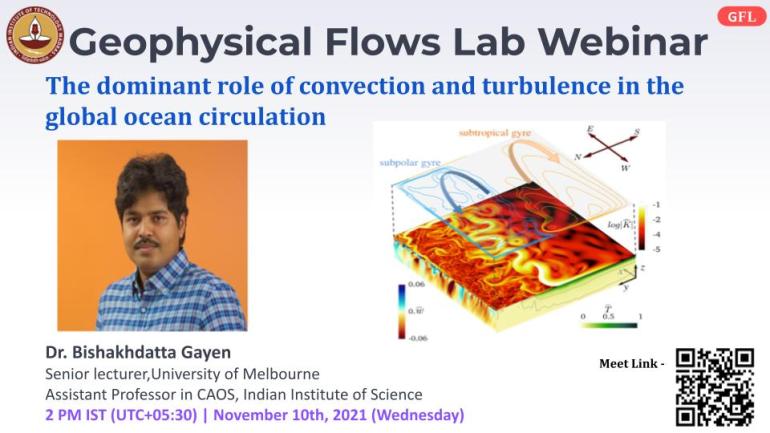
The dominant role of convection and turbulence in the global ocean circulation
Date10th Nov 2021
Time02:00 PM
Venue Google Meet
PAST EVENT
Details
The Meridional Overturning Circulation (MOC) is a known mass and heat conveyor belt in the global ocean. Thus, it controls the polar mass balance and the moderate climate of maritime. It is also a crucial mechanism in transporting nutrients and carbon dioxide. However, critical questions remain on the drivers of the MOCand the processes governing heat and mass transfer in the major ocean basin. Mechanical forcing(e.g., wind, tide, etc.) has long been regarded to predominantly drive and maintain the MOC, but recent works have revealed that surface buoyancy forcing (heating and cooling, evaporation, and precipitation) can also drive energetic flow in the ocean. However, the role of buoyancy forcing, and convective motion associated with it in the oceans is poorly understood and not well represented in the ocean and climate models. Thus, our understanding of ocean circulation is likely to be limited in predicting ocean adjustments, including heat uptake and any change in the meridional overturning circulation due to global climate change.
Our study shows that global differences of temperature and buoyancy flux at the ocean surface are responsible for small-scale convection at high latitudes, global overturning, and the top-to-bottom density difference in the oceans. With planetary rotation, the convection also contributes to the large-scale horizontal, geostrophic circulation, and it crucially involves a 3D linkage between the geostrophic circulation and vertical overturning. The governing dynamics of such a surface-forced convective flow are fundamentally different fromRayleigh–Benard convection. Geostrophic balance adds to the constraints on transport in horizontal convection, as illustrated by experiments, theoretical scaling, and turbulence-resolving simulations for closed (mid-latitude) basins and an annulus or reentrant zonal (circumpolar) channel. In these geometries, buoyancy drives either horizontal mid-latitude gyre recirculations or a strong Antarctic Circumpolar Current, respectively, in addition to overturning.
Biography of the speaker: Dr. Gayen received a degree in Bachelor of Mechanical Engineering from Jadavpur University, Kolkata in 2006, and an M.Sc. degree from the JNCASR, Bangalore, in 2007. He was then awarded a University of California GraduateFellowship and received an M.S. (2010) and Ph.D. (2012) from UC San Diego. He is currently an Australian ResearchCouncil (ARC) Future Fellow and senior lecturer in the Mechanical Engineering Dept, University of Melbourne, and A/Professor in CAOS, IISc. Dr. Gayen is highly recognized internationally for his cross-disciplinary research across fluid dynamics, environmental engineering, and climate processes by addressing the fundamental physical mechanisms. His research includes the development of the ocean models with fully resolved turbulent convection and boundary layer processes, which provides important new insights to the role played in global ocean circulation by convection below the sea surface in polar seas as well as melting of Antarctic ice shelves. He was awarded the Andreas AcrivosAward (for Outstanding Dissertation in Fluid Dynamics) from the American Physical Society (2013), Discovery Earlier Career Research Award from ARC (2014), RJL Hawke Fellowship from The Australian Antarctic Division (2017), and recently, the John Booker Medal from the Australian Academy of Science (2021).
Speakers
Dr. Bishakhdatta Gayen
Geophysical Flows Lab

